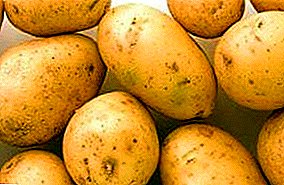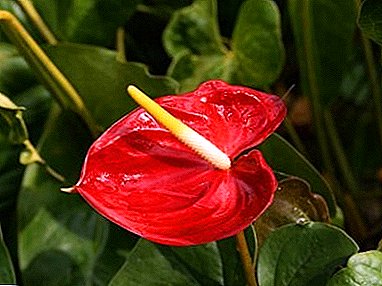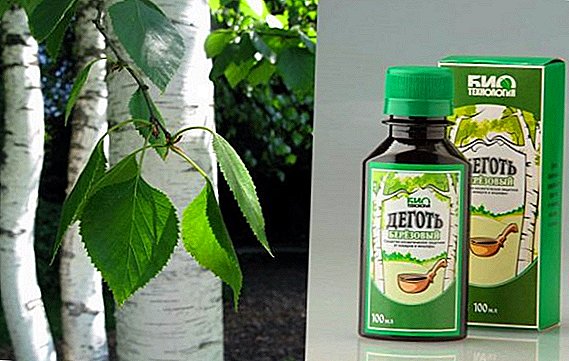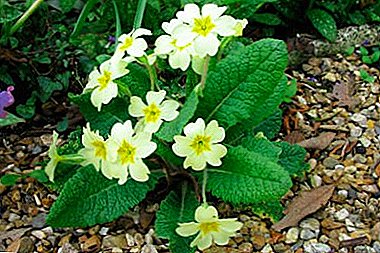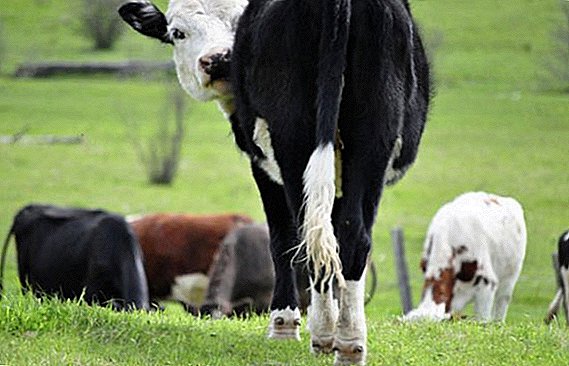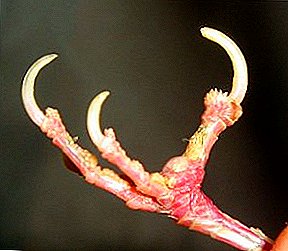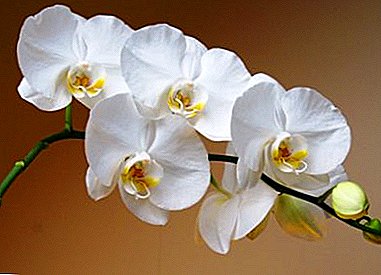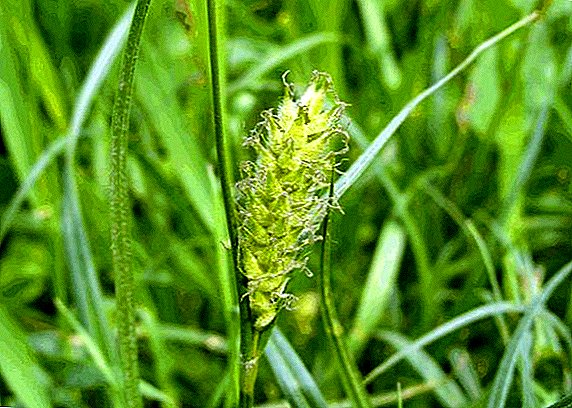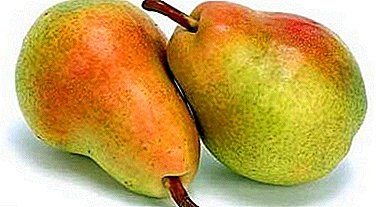 Anthurium red is an unusual and very attractive plant that has won the position of flower growers with an unusual shape and brightness of color of flowers. It will not be difficult to grow it at home, so even novice florists can easily have a flower in the room greenhouses. What this plant looks like and what you should know about the nuances of caring for it - read about it below.
Anthurium red is an unusual and very attractive plant that has won the position of flower growers with an unusual shape and brightness of color of flowers. It will not be difficult to grow it at home, so even novice florists can easily have a flower in the room greenhouses. What this plant looks like and what you should know about the nuances of caring for it - read about it below.
Botanical description of the plant
Anthurium red - a plant belonging to the family of Aroids, the genus Anthurium. Due to the bright red bloom, it is characterized by increased decorative effect and will become a real decoration of any home. Its leafy plates are dark green, heart-shaped or arrow-shaped, and are located on thin, but at the same time strong, stems. This kind of genus reaches at least 75 cm in height, although many specimens grow to 80 cm, with a width of up to half a meter.

During flowering on the peduncles, an inflorescence is formed that resembles a spike: it is the most beautiful part of the plant. The color of the emerging colors is almost always red, often reaching dark red. Under good growing conditions, there may be no breaks in flowering, except that during the winter period the flowers will completely disappear from the plant for 1-2 months.
Ideally, anthurium produces new flower stalks from each leaf sinus, and they all last for about 5-6 weeks. The continuous appearance of peduncles ensures long flowering and the preservation of high ornamental for a long time.
Important! The plant is characterized by the active formation of children, which, like the main bush, can produce flower stalks with flowers. In the form of the mother they are always more, and the kids a little less.
Conditions for growing at home
Anthurium red, like any other type of this plant, cannot be called unpretentious, therefore, when it is home grown, first of all it is necessary to create suitable conditions for the active growth and development of the flower.
Location and lighting
Since anthurium comes from the tropics, it prefers diffused sunlight, but at the same time it should be sufficient for active photosynthesis in the leaves. The window sills at the southern windows for placing the pot will not work, as with regular exposure to direct sunlight, flowers and sheets may burn, and the leaf plates themselves will begin to turn yellow, curl and fall off.

At the same time, a plant placed in the central part of the room or in a low-lit corridor will never release flower stalks with flowers, therefore the best location for the anthurium would be the east or west side of the house with enough light, but without prolonged exposure to the scorching sunlight. On cloudy days, the use of artificial light sources, the role of which is well suited fitolampy.
Pay attention to such types of anthurium as Scherzer and Andre.
Air temperature and humidity
Considering the heat-loving nature of a plant, the constant temperature in its growing room should be kept at + 20 ... + 25 ° C in summer and not lower than + 18 ° C in winter. The decrease in these values leads to the death of the plant.

As for the appropriate level of humidity in the room, it can meet the standard indicators of 40-50%, but in this case, in the summer period you will have to perform regular spraying, at least once a day. To provide the plant with a proper level of humidity, you can place the pot in the bathroom, especially if its size and level of lighting allows it. In the warm season it is useful to take the flower to the street, but it is obligatory only in a shady place, protecting it from direct sunlight.
Did you know? Any type of anthurium is considered to be an exclusively male variant of plants, capable of increasing the vital energy of the representatives of the stronger sex and improving the general atmosphere in the house, giving family happiness and well-being.
Home care
When caring for a houseplant, you should always pay special attention to the mode of watering, fertilizing, transplanting and even pruning, the process of which has many characteristic features. This also applies to the cultivation of red anthurium, which will not be able to please you with lush flowering without following the requirements described below.
Watering rules
The soil in a plant pot should always be slightly damp, but without stagnant moisture. On average, the flower is watered 2-3 times a week, reducing this frequency only in the winter dormancy period. Irrigation fluid should always be well separated (at least 5 days) and filtered, especially when it comes to plumbing.

A slightly acidified liquid is also considered suitable for irrigation - 2-3 drops of lemon juice are dissolved in 1 liter of water. Periodic watering with such a composition ensures the harmonious development and accelerated flowering of anthurium.
Top dressing
In general, anthurium responds positively to moderate supplements, but at the same time it does not like oversupply of nutrients in the soil. In order not to be mistaken and not to allow an overdose, it is important to feed the flower only in the spring-summer period with regularity once in 1-1.5 months.
From nutritional mixtures suitable universal complex fertilizers for indoor flowers or organic compounds - however, their concentration should be reduced by 2-3 times the value recommended by the manufacturer. An overabundance of micro and macro elements is sometimes more destructive for a flower than their shortage, so if you doubt the relevance of using the selected composition, then it is better to wait a little with top dressing.
Important! If the anthurium is sick or pests were found on it, then it is better to postpone the additional feeding. It is necessary to delay the introduction of nutrients in the case when it comes to young, poorly rooted copies with a weak root system - almost any form is able to burn tender roots.
Pruning
Forming pruning anthurium is not needed, but the flowering flower stalks will have to be removed after each flowering. Carry out this procedure extremely carefully and only with a sharp knife that does not leave a burr at the cut points: they must coincide with the very base of the bud, and to avoid rotting the surface, it is better to sprinkle with crushed activated carbon.
Alternatively, you can wait until the coverlet of the inflorescence dries out, and after that remove it - with time the core dries out completely and very easily separates from the flower. Faded or rotted leaves are subject to removal, and the dried edges of healthy leaf plates can also be cut off.
Transfer
In the first two years of the plant’s life, the transplant may not be performed, since the flower has enough space in the pot. From the third to the fifth year of cultivation, the plant will have to change the place of growth annually, and then every 2-3 years. Moreover, each time the drainage layer should become more and more, and the plant - to go deeper into the soil.

A flower pot should be fairly flat, but only 2-3 cm wider than the previous one. The material used to make such a product does not have a fundamental difference, but to avoid possible stagnation of moisture at the roots, it is advisable to choose ceramic options or plastic containers, but always with drainage holes.
Anthurium soil should be loose and quite nutritious. In finished form, it can be store soil for bromeliads, orchids or even cacti, but with the obligatory content of peat, which makes the substrate more friable. If there is no purchased soil, you can prepare it yourself by mixing peat, sand and humus, with the addition of a small amount of pine or spruce needles.
Important! To increase the air permeability of too dense soil mixture, you can add pieces of coal, foam or very small pebbles to the prepared substrate.
The transplant process is based on a number of standard actions:
- Filling a new planting tank with a drainage layer and prepared soil (approximately 1/3 of the total volume).
- Removing a plant from an old pot and placing it in a new planting container.
- Filling the remaining space with a soil mixture, without sealing around the stem, but with little subsequent watering.
- To maintain sufficient moisture, you can cover the surface with sphagnum moss.
For the next 3-4 days, the plant can still be left at the old place, but in the future it is better to move it to a more illuminated diffused light sill of the eastern or western windows.
Breeding
Reproduction of indoor plants is one of the urgent tasks for any gardener, because not only can you get more of your favorite flowers, but you can also save some of the specimens from dying as a result of the decay of part of the rhizome.

When growing an anthurium, there are many ways to perform such a procedure: division of a bush, grafting (leaves and shoots), and seed propagation are equally well suited.
Dividing bush
This method is only suitable for experienced florists, because it requires high precision of all the actions performed. Anthurium roots are characterized by increased fragility, so there is always the likelihood of damage. The rhizome is separated manually, and so that at each received part there will be at least one growth point and 3-4 leaves: this is the only way to guarantee the quick survival of the plant in a new place.
To obtain planting material, you must perform the following steps:
- Choose an adult plant of red anthurium with a large number of lateral offspring.
- Prepare a separate planting tank filled with a two or three centimeter drainage layer and a small amount of soil mixture.
- Carefully remove the flower from the previous pot and separate the shoot from the mother plant with a small part of the root system.
- Seat each bush in separate planting containers and fill it with the remaining soil, almost to the edge of the pot.
Did you know? Many indoor plants have a unique ability to absorb negative energy in the home. For example, the Tradescantia will protect residents from envy, and geranium will save from the evil eye.
It is noteworthy that the reproduction of anthurium by dividing the bush allows you to get a new blooming specimen already in the first - second year of cultivation.
Shoots
The cuttings of indoor plants is one of the most popular and affordable methods of their reproduction, since the apical cuttings always take root quickly and easily in a new place.
The main thing is to follow certain rules of the procedure, the main ones being the following:
- You can harvest cuttings only from healthy plants that are not damaged by diseases or pests.
- There should be an intact point of growth on each chosen segment of the shoot.
- The optimal length of the cutting is no more than 2-3 internodes.
- After cutting, each cut should be dried for 10-15 minutes and only after that it should be planted in the soil - this time will be enough to prevent further germination of the sprouts.

The process of grafting red anthurium consists of several important steps:
- The separation of a suitable cutting from the mother plant - the cut is made with a sharp knife at an oblique angle.
- Rooting of the segment in water (cooled boiled) or soil mixture until the first roots appear on it. At the bottom of the tank with water, you can throw a tablet of activated carbon, and it is advisable to prepare a suitable substrate from an equal amount of peat, sand and perlite. Planting of planting material in a separate container for rooting should be carried out to a depth of 5 cm, and for quick adaptation, you can cover cuttings with an inverted can or create a small greenhouse using a plastic bag. The average term rooting - 2-3 weeks.
- Transplanting rooted cuttings in a permanent pot and organization of further care. These procedures are performed in the same way as with a conventional transplant, using the same soil composition.
In order for the stalk to take root well in the new place and start flowering, it will take at least two years.
Leaves
The reproduction of anthurium by leaf plates in many ways resembles the process of cuttings by shoots, with the only difference being that instead of the above-described segments, healthy leaves are used (together with the petiole). Before being placed in a prepared substrate, they must be carefully twisted into a tube and fixed in this position with an office gum.
Also read why anthurium does not bloom and what to do.
The dredging into the soil is performed for almost the entire length of the sheet; only 1/3 of the twisted tubule should remain on the surface. However, the success of the rooting process in any case depends on the correctness of the cut and nutritional value of the soil mixture: in this case, it is better to purchase ready-made soil for growing violets.
To speed up the rooting of leaf cuttings will help plastic cap or plastic film that will help create the effect of a greenhouse on the handle. If all growing conditions are observed, the first sprout will appear from the center of the tube about a month after planting in the soil. It is possible to transplant a young plant to a permanent place of growth not earlier than in 2-3 months.
Seeds
The easiest way to get suitable planting material is to buy it from a specialty store or from familiar collectors, but you should check its expiration date (anthurium seeds germinate in 3-4 months after collection).
At home, productive seeds can only be obtained by artificial pollination of flowers: during the flowering period, it is necessary to collect pollen (a soft brush) from the ear of the first flower and, wrapping it in a sheet of paper, put it in storage in the refrigerator, where the billet should be kept until it appears on the plant second flower. Next, the second flower must be pollinated with collected pollen.

To ensure the success of the procedure, it is worth repeating it 4-5 days in a row. Bright fruits and berries appear on the plant no earlier than 8-12 months after the procedure. In each of them, 1-4 seeds are hidden, which, after extraction, must be thoroughly rinsed with water and soaked for 2 hours in a weak solution of potassium permanganate, which will prevent the formation of mold.
The process of sowing the prepared seeds does not take much time - for this you should:
- Prepare a box for seedlings and fill it with a suitable substrate (can be a mixture of peat and sand).
- Sow the seeds to a depth of 0.5 cm or simply spread them out on the surface of the soil, only slightly sprinkled on top.
- Moisten the substrate with a spray bottle and cover the seedlings with film or glass, seeking to create a greenhouse effect.
Before the emergence of shoots, it is necessary to air the soil daily and, as necessary, moisten it with a spray bottle, maintaining the temperature in the room at + 25 ° C. Usually, the germination of sown anthurium seeds takes no more than 1-2 months, and the flowering of a new plant can be observed only after 4 years.
Diseases and pests
Among the diseases for anthurium, parasitic fungal diseases are dangerous, in particular, anthracnose, which manifests itself in shrinking of the edges of the leaf plates and in partial or complete dying off of the whole plant. Like pests, these problems can affect the normal flowering of anthurium, so make sure that the soil is always optimally wet (without accumulation of excess moisture), there are no drafts in the room, and the plant leaves have enough sunlight.

In the fight against anthracnose and other fungal diseases of red anthurium, drugs such as Previcur, Scor, Ordan, Fundazol can be used in the dosages indicated on the package. Of the malicious insects on the flower mainly lodge aphids, scutes, spider mites and thrips, which actively feed on the sap of the plant and lead to its death.
With the slightest changes in the state of anthurium, inspect the flower well, paying particular attention to the inside of the leaf plates, since it is there that colonies of pests are usually clearly visible. Also pay attention to the mounting points of the leaf plates, and if they have thin cobwebs, then the plant most likely suffers from a spider mite.
Of the most effective insecticidal preparations for pest control of domestic flowers, the following preparations can be distinguished:
- Aktara;
- Actellic;
- "Flumate";
- Oberon;
- "Akarin";
- Omite;
- "Fitoverm";
- "Biotlin";
- "Spark".
Read more about the main diseases and pests of anthurium.
Knowing how to care for a beautiful and exotic plant, the risk of developing any of the problems described can be minimized, and if signs of illness or the presence of pests do occur, then it will be much easier to cope with them.Pay due attention to your flower, and red anthurium will always delight you with its high decorative properties.


